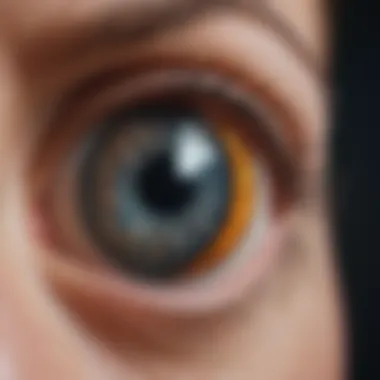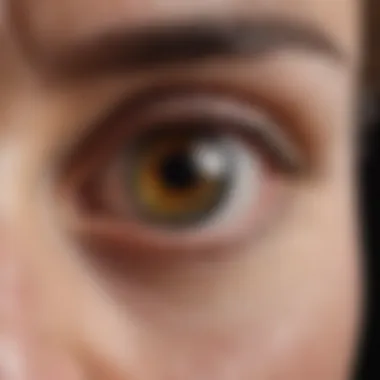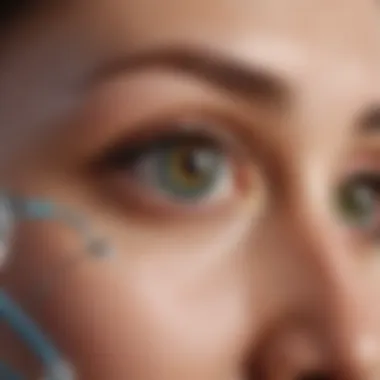Cataract Surgery's Influence on Glaucoma Risk


Intro
Cataract surgery is a common procedure that many patients undergo to restore their vision. However, the link between this surgical intervention and the development of glaucoma is a topic of considerable discussion among healthcare professionals and researchers. For patients and practitioners alike, understanding this relationship is crucial, especially considering that glaucoma can lead to irreversible vision loss if not managed effectively. In this article, we will navigate through this intricate landscape, shedding light on how cataract surgery might influence the risk of glaucoma, along with various factors that can affect its occurrence post-surgery.
We will start by exploring the key findings from recent research, delving into study methodologies that provide context and build a foundation for our discussion. We'll then set the stage by examining the historical background of cataract surgery and its evolution in current medical practices, marking critical shifts in understanding the implications of this common procedure.
By the end of this exploration, we aim to clarify any misconceptions surrounding the relationship between cataract surgery and glaucoma development, provide critical insights into intraocular pressure management, and discuss relevant preventative measures and post-operative care that physicians can recommend to their patients.
Foreword
Understanding the intersection of cataract surgery and glaucoma development is a matter of great significance within the ophthalmological community. It presents a unique exploration of how surgical interventions, particularly in aging populations, can impact ocular health outcomes. As cataracts are prevalent among older adults, cataract surgery becomes a common procedure, but its relationship with glaucoma is not as widely known and can lead to a myriad of concerns for both patients and practitioners.
The nuances of this connection are essential. Cataract surgery can potentially alter intraocular pressure, which is a pivotal factor in glaucoma risk. This article will illuminate the complexities of how these two conditions interact, providing clarity on risk factors, surgical techniques, and post-operative care considerations. It is a territory that merits attention, considering the rising statistics on cataract and glaucoma incidences both in clinical settings and among the general population.
We will cover the following key points:
- Overview of cataracts and their impact on vision
- Definition and implications of glaucoma as a chronic eye condition
- Insight into the surgical treatment options for cataracts and their outcomes
- The research linking cataract surgery to glaucoma
- Risk factors associated with glaucoma that may be exacerbated by surgical interventions
In appreciating this relationship, professionals and patients alike can foster a proactive approach towards managing eye health, enhancing post-surgical recovery strategies, and minimizing potential complications. Recognizing these connections positions healthcare providers and patients towards making informed decisions about treatment pathways and necessary follow-up protocols.
Cataract Surgery Procedures
Cataract surgery procedures are a crucial aspect when considering the interplay between cataract removal and the potential for glaucoma development. Understanding these procedures not only informs patients about what to expect during their surgery, but also provides insights into how the surgical methods may influence post-operative outcomes, including intraocular pressure changes that could lead to glaucoma.
This section will break down the specific types of cataract surgeries performed today, highlighting their individual contributions, benefits, and considerations that patients and healthcare providers should take into account.
Types of Cataract Surgery
Phacoemulsification
Phacoemulsification stands out as the predominant method for cataract extraction in modern ophthalmology. This technique involves using ultrasonic waves to break up the cloudy lens into tiny pieces, which are then suctioned out of the eye. A key characteristic of phacoemulsification is its minimally invasive nature, which typically results in less tissue trauma and a quicker recovery when compared to more traditional methods.
The benefits of this approach are substantial—it often leads to a shorter surgical time, reduced post-operative discomfort, and a faster return to daily activities. However, it's important to recognize that patients with pre-existing conditions might still experience elevated intraocular pressure following this method. In this context, phacoemulsification is not just simply about removing the cataract; it also necessitates close monitoring of intraocular pressure levels post-surgery to ascertain that the risk of glaucoma is managed effectively.
Extracapsular Cataract Extraction
Extracapsular cataract extraction is another surgical option that remains relevant, particularly in more complex cases. This method involves removing the cataract while leaving the posterior capsule of the lens intact. Here, the procedure tends to be a bit more invasive than phacoemulsification but is beneficial for patients with very advanced cataracts or those whose lens are harder or denser.
A unique feature of this technique is that it provides greater access to the eye, allowing for additional interventions if necessary, such as addressing other issues like glaucoma during the same procedure. However, the trade-off is that recovery can be slower compared to phacoemulsification, and there is a heightened risk of complications, including post-operative inflammation and increased ocular pressure.
Post-Surgical Recovery
Recovery post cataract surgery is paramount to ensuring optimum results. Following either type of surgery, patients need to follow specific guidelines to allow the eye to heal properly. This phase includes regular follow-up visits to monitor the intraocular pressure, which could experience fluctuations post-operatively.
"Evaluating intraocular pressure during the recovery phase is essential—both for ensuring healing and understanding glaucoma risk."
Medications, such as topical corticosteroids, are often prescribed to manage inflammation and mitigate the risk of pressure spikes. It’s crucial for patients to engage with their healthcare provider about any symptoms that may arise during recovery, as early detection and management of elevated intraocular pressure can mitigate the potential onset of glaucoma.
Intraocular Pressure and Its Significance
Understanding intraocular pressure (IOP) and its role in eye health is crucial when discussing the relationship between cataract surgery and glaucoma development. Elevated IOP is often considered a significant risk factor for glaucoma, a condition that can lead to irreversible vision loss if not properly managed.
When we talk about IOP, we’re referring to the fluid pressure inside the eye. This pressure is maintained by a balance between the production of aqueous humor, the eye fluid, and its outflow. A healthy IOP typically ranges between 10 and 21 mmHg. Patients with readings above this range may be categorized as having elevated IOP, which can be worrisome, particularly post-surgery.


Normal vs. Elevated Intraocular Pressure
- Normal IOP:
- Elevated IOP:
- Ranges from 10 to 21 mmHg.
- Affects the eye’s overall health without causing damage to optic nerves.
- Reading above 21 mmHg could signify a concern.
- Hyperpressure can lead to strain on the optic nerve, which increases the risk of glaucoma.
It’s imperative to monitor IOP closely, particularly after cataract surgery. Patients might interpret their post-operative eye care as straightforward, but unsuspected changes in IOP can complicate recovery. For instance, surgery may trigger transient variations in fluid dynamics which can temporarily raise IOP levels.
"Elevated intraocular pressure is often the proverbial canary in the coal mine for glaucoma development. Addressing it in real-time could mean the difference between preserving vision and irreversibly losing it."
Intraocular Pressure Changes Post-Surgery
Post-surgical IOP changes are not uncommon and warrant careful consideration.
- Immediately following cataract surgery, many patients experience fluctuations in IOP.
- Some may see a temporary spike in pressure due to inflammation or the changes in fluid flow. This can neutralize itself as the eye heals.
- However, in a subset of patients, this spike could lead to prolonged elevated pressure, thus necessitating further interventions.
The mechanisms at play can be complex:
- Surgical trauma can result in swelling around the drainage angles of the eye, leading to temporary blockages.
- Conversely, improved vision and lowered lens obstruction from cataract removal can facilitate better aqueous humor outflow once inflammation subsides.
Regular follow-ups post-surgery allow for tracking these trends in IOP, promoting timely intervention when necessary. The eye care practitioner can recommend medications or additional treatments based on IOP measurements, aiming to mitigate the risk of developing glaucoma.
All in all, maintaining IOP in the normal range is not merely a matter of comfort; it’s a pivotal aspect of safeguarding ocular health. Managing this pressure effectively after cataract surgery could influence the trajectory of a patient’s visual health in profound ways.
Linking Cataract Surgery to Glaucoma
The link between cataract surgery and glaucoma is a vital topic, capturing the attention of medical professionals and researchers alike. Understanding this connection is paramount, as it opens doors to better patient management and informed decision-making. When patients undergo cataract surgery, the procedure does not merely address cloudy lenses; it also plays a role in the dynamics of intraocular pressure (IOP), which is closely tied to glaucoma.
Complications can arise that increase the risk of developing glaucoma post-surgery, making it essential for healthcare professionals to recognize these risks early. Furthermore, discerning the nuances of this connection can empower patients with knowledge, guiding them on what to expect during their recovery period and what symptoms might indicate trouble.
Research Findings
The body of research surrounding cataract surgery and its correlation with glaucoma is both diverse and enlightening. Some studies indicate that IOP may rise after surgery, while others point toward a reduction in pressure, particularly for patients with pre-existing glaucoma. These findings are pivotal in shaping pre-operative evaluations and post-operative care strategies. Notably, a study published in Ophthalmology observed that post-operative IOP spikes can occur within the first few days, after which levels may stabilize, depending on several factors including the surgical technique used and the patient's individual risk factors.
- Study highlights:
- Immediate post-operative IOP spikes can occur, ranging from 2 to 19 mmHg for various patients.
- Patients with a history of elevated IOP or glaucoma are particularly at risk for higher post-surgical pressures.
- Long-term outcomes can vary significantly, emphasizing the need for ongoing monitoring.
The variability in these findings stresses the importance of personalized treatment plans. By tailoring care to individual risk factors, such as age, baseline IOP, and other ocular conditions, surgeons can better mitigate risks associated with glaucoma development post-cataract surgery.
Mechanisms of Glaucoma Development
To untangle the relationship between cataract surgery and glaucoma, it’s crucial to delve into the mechanisms at play. When cataract surgery is performed, several physiological changes occur within the eye. The removal of the lens and subsequent adjustments in the ocular anatomy can influence aqueous humor dynamics, potentially altering IOP.
One key aspect of this mechanism is the role of the trabecular meshwork, the site where the aqueous humor drains from the eye. Surgical interventions might inadvertently lead to changes in the outflow system, exacerbating any pre-existing conditions that predispose the patient to glaucoma. Moreover, scarring or inflammation resulting from surgery can also pose a challenge to normal aqueous drainage, further heightening the risk.
- Key mechanisms to consider:
- Alterations in the trabecular meshwork due to surgical trauma.
- Changes in aqueous humor production and outflow dynamics.
- Post-operative inflammation leading to increased IOP.
By understanding these mechanisms, ophthalmologists can develop targeted therapeutic strategies, including medications to manage IOP changes and regular follow-ups to monitor eye health effectively. Ultimately, the intricacies of this relationship highlight the need for continuous research and education for both patients and practitioners.


Risk Factors for Glaucoma After Surgery
Understanding the risk factors associated with glaucoma after cataract surgery is crucial for both patients and healthcare providers. It brings to light how various elements interplay and contribute to the likelihood of developing glaucoma, especially in individuals who are already vulnerable. Elevated intraocular pressure (IOP) is a key player in glaucoma onset, making it paramount to recognize the factors influencing IOP changes during and after surgery. Knowing these risk factors can also aid in preparing an effective management plan tailored to individual needs.
Pre-existing Conditions
Certain pre-existing conditions can significantly heighten the risk of glaucoma following cataract surgery. These might include:
- Diabetes: This condition can affect the optic nerve and lead to diabetic retinopathy, which, when paired with cataract surgery, may increase glaucoma risk.
- Hypertension: Elevated blood pressure can exacerbate changes in intraocular pressure, particularly after surgical intervention, making careful monitoring essential.
- Existing Glaucoma: If a patient has a history of glaucoma, there is a greater likelihood that surgical procedures will aggravate the condition or lead to further deterioration.
Managing these risk factors early on can be beneficial. Patients should have open discussions with their ophthalmologists about their medical history and how it might relate to the outcomes of cataract surgery.
"Each patient is unique, and understanding their health history is key to effective glaucoma management post-surgery."
Demographic Factors
Demographic variables offer insights into how certain groups may be more susceptible to developing glaucoma after cataract operations. Specifically:
- Age: Older adults generally face a higher risk due to age-related changes in the eye, including decreased elasticity and changes in drainage mechanisms, potentially influencing IOP.
- Gender: Research shows mixed findings, but some studies suggest women may experience a different surge in risk factors due to hormonal changes affecting IOP.
- Ethnicity: Certain ethnic groups, particularly those of African ancestry, have higher incidences of both cataracts and glaucoma. This complexity can affect surgical outcomes and postoperative care.
Recognizing these demographic nuances can assist eye care professionals in developing more personalized postoperative care for their patients and may help in anticipating complications.
Preventative Strategies
Preventative strategies play a vital role in safeguarding patients who have undergone cataract surgery from the risk of developing glaucoma. Understanding the nuances of these strategies can help in managing intraocular pressure effectively and enhancing overall patient outcomes. Glaucoma often presents silently, with few noticeable symptoms until significant damage has occurred. Thus, having a proactive approach towards prevention is crucial.
Monitoring Intraocular Pressure
Monitoring intraocular pressure (IOP) is a cornerstone of glaucoma prevention strategies post-cataract surgery. Regular check-ups allow for the early detection of any pressure spikes that may indicate an upcoming problem. Here are several critical aspects of IOP monitoring:
- Frequency of Checks: After surgery, patients should have their IOP checked at regular intervals. This often starts from one month post-operation, with follow-ups at three and six months, depending on individual risk factors.
- Techniques Used: Eye care professionals typically use tonometry for measuring IOP, which can involve different methods such as Goldmann applanation tonometry or non-contact methods. Each technique provides important insights into the health of the eye.
- Individualized Care Plans: IOP targets can vary from patient to patient. Factors such as age, family history, and pre-existing conditions dictate these targets. Tailoring a care plan towards each patient’s needs can enhance efficacy in preventing glaucoma.
- Patient Education: It’s crucial for patients to understand the reasons for these follow-ups. Discussing the risks involved post-surgery and emphasizing the importance of regular checks can encourage compliance.
"Regular monitoring of intraocular pressure is not just a task; it's a lifeline for those at risk of developing glaucoma."
Medication Management
Apart from monitoring, effective medication management is essential for glaucoma prevention among post-cataract surgery patients. The role medications play can be multi-faceted, addressing both pressure control and inflammation that can arise from surgery. Considerations in medication management include:
- Timely Medication Initiation: Some patients may need to start glaucoma medications immediately after surgery. This proactive approach can prevent potential pressure increases before they become problematic.
- Types of Medications: Various medications can be prescribed, ranging from prostaglandin analogs to beta-blockers, each with specific mechanisms for lowering IOP. Understanding the purpose and function of each type can be beneficial for patients.
- Possible Side Effects: Patients must be educated about potential side effects. For example, some may experience changes in iris pigmentation or eyelid skin. Clear communication regarding these effects can help patients manage their expectations.
- Adherence to Treatment Plans: Ensuring that patients adhere to their prescribed medication regimen is crucial. Regular follow-up appointments and discussions about any difficulties they might face will aid in compliance, which is a significant factor in effective glaucoma management.
Patient Education and Awareness
Patient education plays a pivotal role in enhancing outcomes for individuals undergoing cataract surgery, particularly regarding the potential risk of developing glaucoma. In this context, awareness is essential, as it empowers patients to make informed decisions about their treatment and post-operative care. Understanding the nuances of treatment choices, alongside recognizing the importance of regular follow-up visits, can significantly influence a patient's recovery trajectory and overall eye health.
Understanding Treatment Choices
The journey through cataract surgery doesn’t end with the procedure itself. Patients must be well-informed about various treatment options, which can range from the type of surgical technique to the kind of lens implant they choose.
For instance:
- Phacoemulsification is often the preferred method, known for its minimally invasive nature and quicker recovery time.
- Extracapsular Cataract Extraction might come into play for more advanced cataracts.
Patients should also explore the implications associated with different kinds of intraocular lenses. Options like toric lenses can assist those who also experience astigmatism. Having a comprehensive understanding of these choices allows patients to weigh their options effectively, ensuring they select what aligns best with their vision goals and lifestyle. As with any medical procedure, it's critical to discuss personal medical histories, potential medications, and the effects of these therapies with healthcare providers, tailoring approaches to individual needs.


Importance of Follow-Up Visits
Regular follow-up visits after cataract surgery are vital. These appointments allow healthcare providers to monitor the patient’s recovery and check intraocular pressure, which is particularly relevant in relation to glaucoma risk.
"Follow-up care is not just routine; it’s a lifeline for patients navigating the aftermath of surgery."
During these visits, healthcare professionals can:
- Identify early signs of glaucoma, which is crucial as the disease can develop insidiously, often with no symptoms until it's at a more advanced stage.
- Adjust medications if necessary. Some patients might need to adopt treatments to manage intraocular pressure effectively, based on their individual risk factors.
- Provide education on lifestyle changes. Simple adjustments, like staying hydrated and avoiding certain medications, can mitigate risks.
Staying on top of these follow-up appointments is an act of self-advocacy; it demonstrates an understanding that proactive care is foundational in preserving vision health post-surgery. With the right knowledge and support, patients can navigate their eye care journey with confidence.
Future Directions in Research
Understanding the relationship between cataract surgery and the onset of glaucoma is a continuously evolving field. Future directions in research hold the potential to significantly refine our comprehension and management of these ocular conditions. Focusing on this area is crucial for several reasons, primarily related to advancements in surgical techniques, development of new medications, and the overarching goal of improving patient outcomes.
Innovations in Cataract Surgery
Innovations in cataract surgery are revolutionizing the way professionals approach treatment. The emergence of technologies such as femtosecond laser-assisted cataract surgery (FLACS) represents a significant step forward. This technique enhances precision during the procedure, minimizing trauma to surrounding tissues. As a result, this may influence intraocular pressure (IOP) stability post-surgery. What’s more, these advancements provide an opportunity to explore procedures that could reduce the risk of triggering or exacerbating glaucoma in susceptible patients.
Another notable innovation includes the development of intraocular lenses (IOLs) designed specifically for patients with a history of glaucoma. These lenses can feature advanced designs that mitigate IOP increases post-surgery, ultimately fostering a more favorable post-operative environment for those at risk. Researchers are also diving into the use of personalized medicine, tailoring surgical approaches based on genetic predispositions to glaucoma, which could enhance prevention efforts.
Emerging Studies on Glaucoma
The landscape is also changing through emerging studies on glaucoma, focusing on various aspects such as the pathophysiology and treatment. For instance, novel biomarkers are being investigated to assess the likelihood of glaucoma development following cataract procedures. By identifying at-risk individuals earlier, clinicians could implement monitoring strategies or treatments sooner, potentially altering the course of the disease.
Furthermore, the relationship between inflammation and glaucoma is garnering increasing attention. Understanding how the inflammatory response provoked by cataract surgery might lead to increased IOP could guide future interventions. Research into anti-inflammatory medications shows promise in managing IOP fluctuations, thereby curbing the risk of long-term glaucoma.
Another angle involves exploring the interplay between different medications and their effects on postoperative IOP. Studies attempting to refine existing glaucoma medications or even develop new ones suitable for post-cataract surgery patients could change standard care practices.
As our understanding deepens, the findings from these studies could reshape treatment paradigms, ensuring that patients not only recover from cataract surgery but also have their risk of glaucoma minimized.
For the most current and detailed insight into ongoing research, websites such as Wikipedia provide a wealth of information which often sparks new inquiries into the relationship between surgical practices and ocular health.
By supporting ongoing research and being open to new ideas, professionals can better navigate the intricate ties between cataract surgery and glaucoma, ultimately benefiting patient care and outcomes.
In summary, the future directions in research not only focus on the procedural aspects but also pave the way for technological and pharmacological innovations that can change the narrative around glaucoma post-cataract surgery. The journey ahead promises to be as important as it is complex.
Ending
The relationship between cataract surgery and the risk of developing glaucoma is multifaceted. Understanding this connection is crucial not just for eye care practitioners but also for patients who are preparing for surgery. The insights garnered from the findings discussed throughout this article highlight several important elements that must be considered post-operation.
- Intraocular Pressure Monitoring: After cataract surgery, monitoring intraocular pressure becomes paramount. Even though surgery aims for clearer vision, sudden changes in pressure could lead to complications, emphasizing the importance of routine check-ups.
- Patient Awareness: Educating patients about the risks associated with their surgical choices is essential. If individuals are aware of the potential impacts on eye health post-surgery, they are better equipped to participate in their own care.
- Research Insights: As new studies continue to emerge, they could provide more clarity on how these surgeries may influence glaucoma onset. Ongoing research is critical for developing better preventative strategies in surgical practice.
Through the diligent exploration of these elements, we're not just building a better understanding; we’re paving a path toward improved outcomes for patients at risk of glaucoma.
"Knowledge is a treasure, and practice is the key to it."
Summary of Key Findings
The relationship between cataract surgery and glaucoma can be summarized through several key points:
- Post-Surgical Changes: Changes in intraocular pressure can occur after surgery, and understanding these changes is vital for preventing future complications related to glaucoma.
- Significant Research Evidence: Numerous studies indicate that pre-existing conditions significantly heighten the risk of glaucoma in patients undergoing cataract surgery.
- Preventative Measures: Applying preventative strategies, such as proper medication management and regular follow-ups, can substantially lower the risks associated with these procedures.
These findings reinforce that while cataract surgery can be a major step toward better vision, it is not without its potential pitfalls. Each patient’s history and condition pave a unique pathway to how surgery might influence their eye health.
Final Thoughts
As research advances, it remains imperative for both patients and practitioners to stay informed, adapting practices to ensure a reduction in glaucoma incidences post-surgery. Awareness of this relationship can significantly influence treatment approaches, leading to better health management and patient satisfaction.







